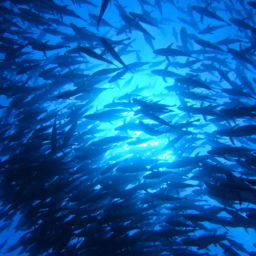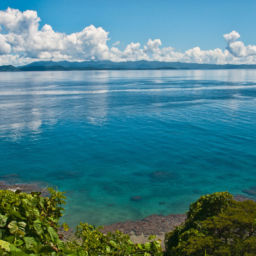On the southern coast of Fiji’s main island, Viti Levu, sits the small coastal town of Pacific Harbour. The streets are lined with serried ranks of palm trees, and narrow waterways wend seaward between banks of dense jungle greenery. The town itself is relatively quiet, and yet Pacific Harbour is the ultimate destination of countless divers seeking an adrenaline rush like no other — this is the departure point for Beqa Lagoon, a site that bills itself as the world’s No. 1 shark dive. Although this self-proclaimed title may seem ambitious, those who have dived Beqa often corroborate the claim. After all, where else in the world is it possible to encounter eight different species of shark within a single dive? Although their most famous residents are undoubtedly the large bull sharks that gather there by the dozen, the clear, warm waters of Beqa Lagoon are also home to white and blacktip reef sharks, tiger sharks, silvertip sharks, nurse sharks, lemon sharks and grey reef sharks. The rare convergence of so many shark species (and in an area that boasts typically good visibility) makes this dive truly exceptional.
Located in an area that looks more like a bay than a lagoon, the Beqa dive sites are just a 15-minute boat ride from shore. Once there, you’ll get an in-depth safety briefing detailing shark-dive protocol before gearing up and slipping into the water. In the first few seconds, there is nothing to see but blue, but as you begin your descent the seafloor materializes below you, obscured now and then by a swirling melee of fish circling directly above the reef. There are darting shoals of gold-and-black striped juvenile trevallies, silvered curtains of baitfish and reef fish, and in between them the predatory silhouettes of game fish on the hunt. Black giant trevallies swim past within touching distance. There are so many fish that it takes several moments to adjust to the riot of color and movement before you; several moments to see beyond the frenetic whirlpool the fish create to the larger shapes cruising beneath them closer to the reef itself.
The sharks are there from the moment we enter the water, approaching from every direction in such numbers that the spectacle is almost surreal. The group’s assigned dive guides watch carefully until we’re kneeling on the volcanic rubble substrate. Here, we become first-row spectators separated from the sharks by only a rudimentary rubble wall a few feet high. Beyond the wall, trained feeders present the sharks with fish heads from a giant trashcan, which they release from outstretched hands as the predators approach. At first, the tangle of sharks jostling for position around the feeders is mostly made up of nurses and lemons. There is a clear hierarchy in place, not only between species but also between individuals; the more boisterous sharks keep the shyer ones at bay, only allowing them access once they’ve had their fill. At a distance of just a few feet, the sharks are spectacular, their sheer proximity allowing us to see subtle points of beauty that are rarely conveyed in photographs or film footage. From the iridescent sheen of the nurse sharks’ golden skin to the ivory whiteness of the lemons’ crooked teeth, the sharks are so impressive that soon any initial nerves I may have had disappear.
Even the belated appearance of the famed bull sharks does not jangle my nerves, despite their fearsome reputation. In fact, although the Beqa bulls are generally among the largest in the world, their presence in the mix radiates order and serenity rather than danger and chaos. Their power is apparent in the sureness of their movements and the casual gape of their razor-lined jaws, yet they take their reward from the feeders gently and gracefully, and despite regularly coming within touching distance, the rapid-fire beating of my heart indicates excitement rather than fear. At the deeper feeding sites you’re almost guaranteed sightings of lemons, nurses and bulls. You stand a chance of glimpsing more occasional visitors there, too, such as the sleek silvertip and the ocean’s true queen, the tiger shark. When they do put in an appearance, the silvertips rarely linger; they are cunning pelagics that dart in to take an offering of fish before disappearing back into the blue with a flick of their gilded fins. The tigers clear the dining room when they come to visit — reaching lengths of up to 15 feet, they are larger by far than the other species vying for the feeders’ attention.
A second dive on Beqa’s reefs usually takes you to the shallower sites, where the ever-present bull sharks continue to reign alongside the smaller reef sharks. After witnessing the awesome power of the larger sharks, the whitetip, blacktip and grey reefs can seem somewhat comical, but they’re no less fascinating to observe in their natural habitat. Although Beqa’s reefs can’t claim the same coral coverage of other Fijian dive sites, they provide a habitat for plenty of other exciting marine life, too, including enormous Napoleon wrasse, inquisitive morays and a plethora of colorful reef fish. Whether Beqa Lagoon can claim the title of the world’s No. 1 shark dive is a matter of personal opinion, but the sheer density of life (shark and otherwise) in the lagoon is staggering, and for that reason alone this dive site undoubtedly deserves its international reputation. Perhaps Beqa Lagoon’s most meaningful claim to fame is the way it changes visitors’ perception of sharks. Many divers approach the lagoon’s shark dive as a challenge, expecting an adrenalin high, fuelled by danger and fear. After completing the dive, the same divers have replaced fear with respect, and leave Fiji as staunch advocates for shark conservation. This is a fantastic opportunity to come face-to-face with these magnificent predators, and to see exactly why the future of all sharks is worth fighting for.



